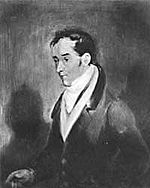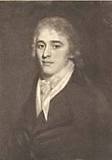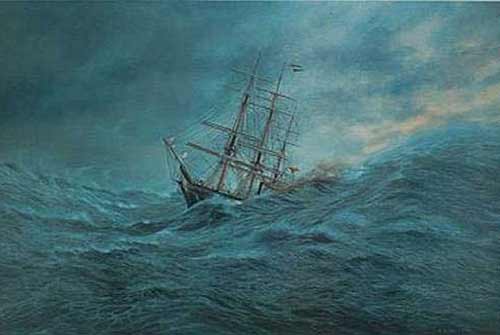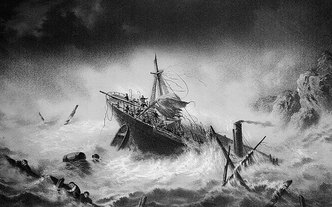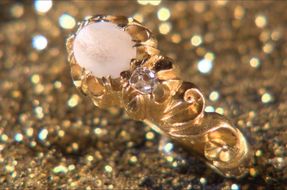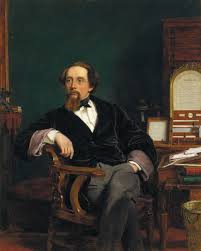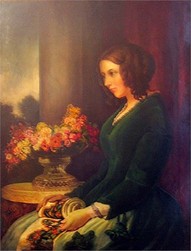Introduction & RecapIn my previous post I introduced you to a few of the people that lived and worked at Lennelhill Farm, Coldstream. In this instalment I intend to dig a little deeper into some of these families and this time, their connections within the literary world. But before I do I would like to add an unusual fact gleaned from the 1861 census for the farm that I omitted last month. It is about Hope. Jean, Margaret & Fanny Hope aged 9,7, & 5 respectively. They are living with their grandparents William Hope, Agricultural Labourer, his wife Jean and four aunts and uncles, bringing the total number living in one of the cramped cottages up to nine. This is not what I found unusual however, it is their place of birth. All three of these young girls were born in "America, New York"! Given the fact that no parent is present, the aunts and uncles all being unmarried at the time of the census, I can't help but be curious as to why & how these young girls made the journey back to Scotland from America? Had their parents died?, who looked after them on their voyage?, and what became of the three after 1861?. I am currently investigating and will update on my findings in due course. Part II - Printers & PublishingHogarth & BallantyneThe granddaughter of George Hogarth tenant of Lennel Hill from 1766 until his death in 1791, and daughter of Robert Hogarth of potato fame was Christian. In January 1816, after a lengthy period of negotiation whereby Christian's prospective husband to be, had to prove himself financially worthy of her hand, she married James Ballantyne.
James initially followed a career in law, and it was whilst completing his legal training at Edinburgh University that his acquaintance with Sir Walter was renewed. His first forays into the world of publishing came in 1796 as editor of the 'Kelso Mail'. In 1799 he printed Scott's 'Apology for Tales of Terror'. As a result Scott actively encouraged James in his new career and in 1802 funded a move to Edinburgh and 'The Border Press' was established. Success brought expansion and a requirement for more capital and in this Scott was again happy to fund his protege. A 'secret' agreement was entered into by the pair that saw Scott stipulating to his publishers that James Ballantyne & Co would print his future works. The required funds were raised by Scott against his yet unwritten works from Archibald Constable, his publisher. Aside from his business ventures with Sir Walter, James entered into partnership with his brother in law George Hogarth, writer to the signet, that provided James with a channel for his increasingly controversial politic views through the acquisition of the 'Edinburgh Weekly Journal'. In the meantime John after initially pursuing a career in banking, followed by a period of continuing his father's business in Kelso, found himself in some considerable financial distress. In 1805 he joined his brother's printing business as a clerk. As a result of the 'secret ' partnership above, and it's apparent success another partnership was formed. In 1809 John was made manager of the newly formed a publishing house & book-selling business. Exuberance, excessive personal spending and lack of business acumen was to prove the downfall of both brothers. In the case of John this was also hampered by failing health. He died at his brothers house in Edinburgh from Tuberculosis on 16 June 1821, virtually penniless. The financial crisis affecting the entire publishing industry brought about the bankruptcy of Scott's publisher Archibald Constable. An intricate web of debt was the result for which Sir Walter took the responsibility for repayment upon himself. His extreme productivity saw him repay nearly £120,000 of not only his own liabilities but also those of the Ballantyne's before his death in 1832. James Ballantyne following the decease of his wife Christian in 1828, depressed and described as "becoming increasingly corpulent and pompous" passed away at his home in Edinburgh in January 1833. Hogarth & PurvesRobert Hogarth, grandson of George of Lennelhill, and brother to Christian was married to Elizabeth Purves. Elizabeth was aunt to James Charles Purves born at Lennelhill in 1827 and who died as a result of the injuries sustained during the Charge of the Light Brigade (see July's post). This section is dedicated to tragic fate which befell two of his cousins and their family. Robert Hogarth continued the family farming tradition at Inland Pastures Farm, Scremerston. Together with his wife Elizabeth they had six children, four daughters and two sons Robert and Peter Purves Hogarth.
Were they chasing the riches promised by the goldrush of May 1851? Did they succeed? This we will never know as along with many others they made the fateful decision to return to England on the infamous "Royal Charter". Of a new and modern design, The Royal Charter was a steam clipper with an iron hull, capable of carrying 600 passengers. With the use of her auxillary engines she was considered to be very fast, being capable of making the voyage from Liverpool to Australia in just 60 days. She was returning from Melbourne, with approximately 371 passengers, many of them gold miners and prospectors laden with gold about their persons. It is also reputed that gold made up a large proportion of her cargo in the hold. On the eve of 25th October 1859 as she approached Anglesey the falling barometer indicated bad weather was imminent. Rather than putting in to Holyhead, Captain Thomas Taylor made the disastrous decision to carry on towards Liverpool. During the night the wind rose to Hurricane Force 12 . As it rose, the wind changed direction forcing the ship towards the rocky coastline, unable to make progress the ship weighed anchor at 11 pm. In the early hours of the 26th both her anchor chains snapped within an hour, and the rising tide drove the ship onto rocks near Moelfre on the North Coast of Anglesey. Battered by the wind and the huge waves she quickly broke up.
The story of the Royal Charter continues to fascinate - with many believing there is still some of the estimated £80m in gold lying on the seabed. For me, no amount of treasure could eradicate the scenes that must have been played out that night, but for those who would like to learn more, below are a couple of links you may find of interest. http://www.youtube.com/watch?v=iIVBiF4S8bI and the Aussie take http://www.youtube.com/watch?v=-kFU6N7XCIY What the Dickens?It is well documented that writer Charles Dickens paid a visit to the wreck site shortly after the disaster. In 'The Uncommercial Traveller' he paints a vivid picture of the aftermath from both personal observations and interviews with the Rev. Hughes whose unpleasant task was the recovery, identification and burial of the bodies. What is not so well documented are his reasons for his visit. Yes, as a writer he would have taken great inspiration from the disaster, but he had a personal reason for being there too. In 1836 he had married one Catherine Thomson Hogarth. The above described Robert and Peter were her cousins. She herself being a great granddaughter of George Hogarth of Lennelhill! SummaryWhen I first set out to research the farm of Lennelhill, I knew there were a few interesting connections, but further research and the writing process has revealed the closeness of the relationship between the people featured in this series of articles. I have to say its not finished yet either .... there are more! As well as more fascinating characters from these families, there is another family, yet unmentioned to bring into the mix. One that brings both colour & more tragedy and reintroduces us to an old friend! This family I can assure you is NOT one you are expecting!! Keeping them secret until the September instalment has been helped enormously by the simple mis-transcription of a surname!
5 Comments
|
AuthorSusie Douglas Archives
August 2022
Categories |
Copyright © 2013 Borders Ancestry
Borders Ancestry is registered with the Information Commissioner's Office No ZA226102 https://ico.org.uk. Read our Privacy Policy

